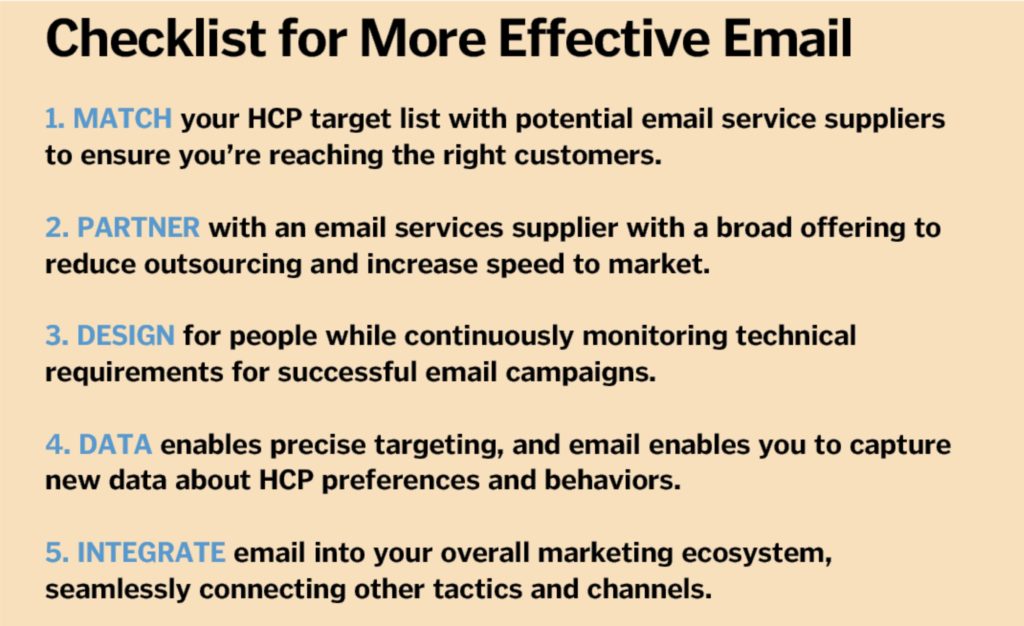While trendy social platforms grab headlines, email has very quietly become the vehicle through which modern communication and commerce is conducted. According to email service provider Constant Contact, over 205 billion emails are now exchanged every day globally, growing to 246 billion by the end of 2019! The return on investment (ROI) for email marketing can be significant, with the Direct Marketing Association (DMA) reporting a whopping $38 returned for every $1 invested. And when it comes to the communications channel physicians most prefer, one recent industry report noted that 68% of physicians prefer to receive information via email.
These are encouraging statistics if you oversee email marketing for your brand, but there’s a downside: Nearly every other company and brand team that wants to reach healthcare professionals will also use email to get the word out about their product, and that makes for some crowded inboxes. Our deep experience has taught us the best ways to cut through healthcare marketing clutter, and some important things to keep in mind as you select an email marketing partner.
 It’s Your Targets that Matter
It’s Your Targets that Matter
Email marketing suppliers are famous for touting the size of their email lists, and size does matter. However, the match rate to your existing HCP target list matters more, so insist on performing a list match to see how a supplier stacks up for your specific audience. You need to determine the go-no go threshold—the minimum percent matched for which you’d still invest in the campaign. However, an unusually low match rate in a particular specialty may suggest that these customers prefer channels other than email for their medical information.
Integration Increases Speed
Email is often a response to an HCP behavior or event that’s important to your brand, and getting the word out immediately is critical to your success. One of the keys to email success is to partner with a supplier that also manages other channels in your marketing ecosystem, such as websites, direct mail, or events. Doing so enables you to quickly repurpose an existing asset into an email marketing piece, reducing internal approval time and better aligning creative across channels. Another time saver is to select an email partner with a robust offering, reducing complexity, time to market, and the partner’s need to outsource.
Design for Humans, Optimize for Machines
Email marketing is like an iceberg, with the email creative at the tip and data management and technical optimization below the surface. The industry has had decades to evolve and fine-tune HCP email creative to ensure it is opened and read by the human recipient. Variable subject lines, headers, copy, links, graphics, calls-to-action (CTAs), and other elements capture a reader’s attention and then direct her to a next action, whether completing a registration form or downloading a report.
However, the non-human factors of email marketing have evolved even faster. Today’s software-enabled spam filters and artificial intelligence tools used by major email platforms can identify, block, and blacklist even useful and desired promotional or informational messages from biopharma companies. Email campaign designers must vigilantly monitor and respond to an ever-changing email landscape of blocked IP addresses and suspect sender domains; trigger words within messages, subject lines, or headers that may get snagged by filters; best days and times to send emails; and the optimal way to tag media files. The best email creative in the world won’t work if it can’t reach, be opened, and be read by its intended receiver.
Email is Increasingly Data-Directed
Email messages must be about something relevant to the target HCP recipient. Whether it’s details about a formulary win, a medical congress recap, news about a recently approved product, or updated prescribing information, it must be personalized based on the receiver’s explicit preferences and data from other sources.
Being able to manage and integrate a variety of client-supplied data sources is critical to an effective campaign, so ensure that your email supplier is experienced working with data from the main data suppliers to the life sciences industry. This will enable you to target your email campaigns based on important elements such as specialty, prescribing behavior, concentrations of formularies within an individual prescriber’s practice, and other elements that can mean the difference between an email that drives results and one that ends up instantly deleted.
Email is Part of a Larger Marketing System
Often, we have a client come to us because they tried to work with a firm that claimed to be an “email marketing expert,” but those “expert” efforts weren’t coordinated with the many other tactics the client was using to launch and maintain an effective marketing program. Look for an email partner that lives and breathes email marketing but also understands that email is just one part of a larger effort. Carefully planning for email to work synergistically with digital, event marketing, direct mail, and the salesforce can deliver an exponentially better outcome.







